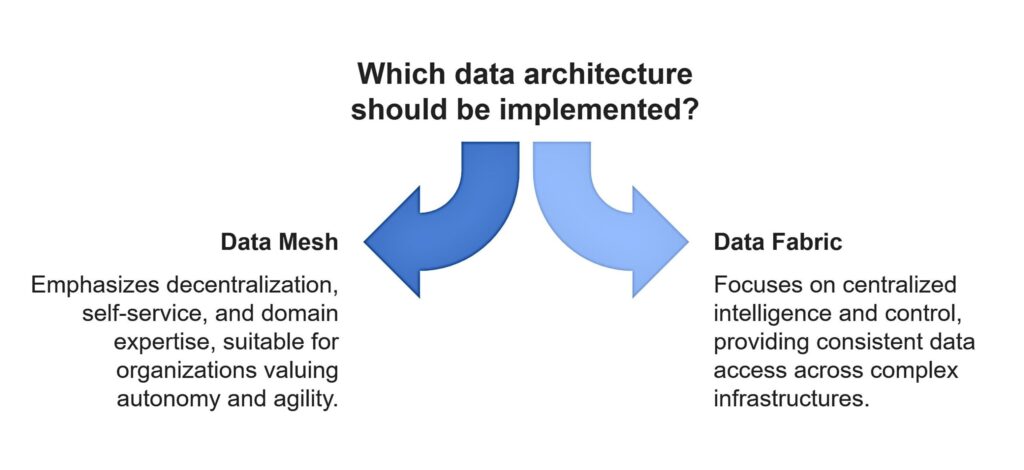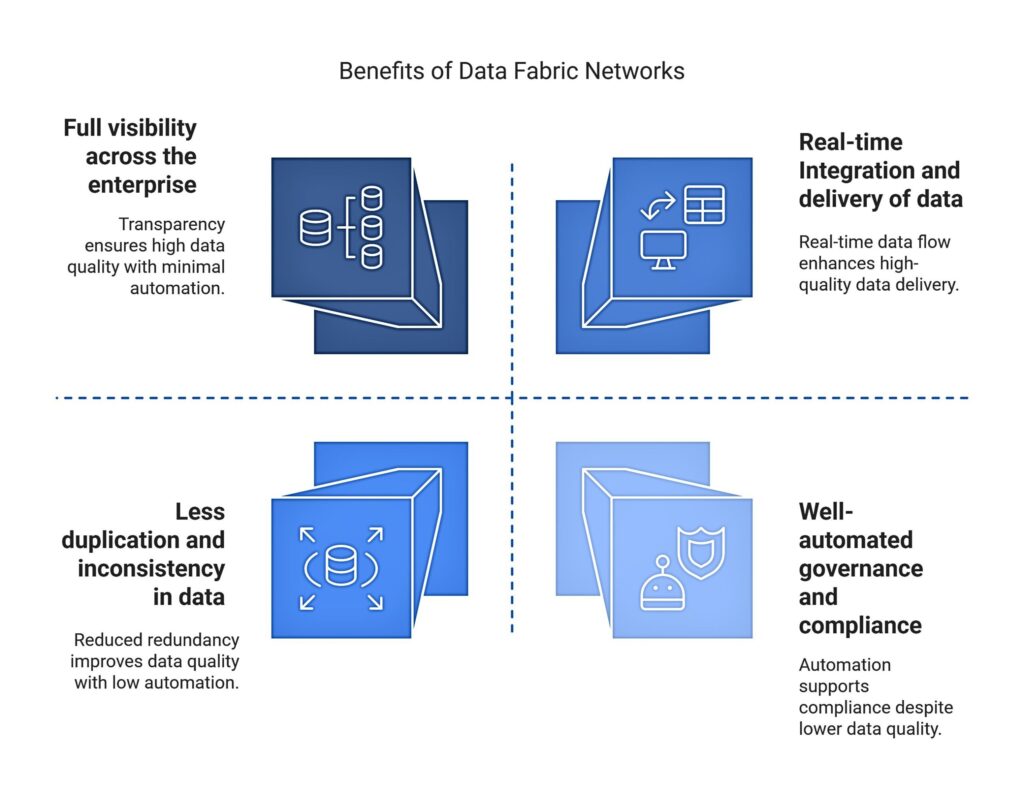- May 13, 2025
Data Strategy Dilemma for Modern SMBs
SMBs are now facing a crucial choice—especially on how to manage, access, and leverage data for overall business empowerment. Emerging with unprecedented data generated daily from various teams and platforms, the concepts of Data Mesh and Data Fabric have comparatively arisen in recent times. Understanding what is data mesh and data fabric is becoming essential for organizations striving to optimize their data strategy.
Traditional models like centralized data lakes are buckling under the demand for real-time activities, dispersed worldwide teams, and accountability. Modern organizations are instead looking for new age decentralized and dynamic systems, often weighing the data mesh vs data fabric approaches to find their best fit.
Understanding Data Mesh and Data Fabric Architectures

At first glance, Data Mesh and Data Fabric may appear quite similar, as both aim to simplify data access and accelerate any decision-making. However, there is a vast difference in their approach and intention. This leads many to ask what is data mesh and data fabric in more detail, especially when trying to grasp the difference between data mesh and data fabric.
Data Mesh is an architectural paradigm that treats data as a product, thereby maintaining an individual’s ownership from business domains like marketing, sales, or HR. The other way around, Data Fabric offers a panoply of technologies and services working across different environments-cloud, on-premises, or hybrid-to automate data integrations, discovery, governance, and delivery.
Centralized vs Decentralized Data Management Models
Intelligent metadata management does play a very crucial role in providing consistent and real-time access to data across the enterprise. The philosophies that govern these two systems vary greatly. While the Data Mesh places importance on decentralization, self-service, and domain expertise, it applies well in organizations where autonomy and agility are comparatively maintained.
On the contrary, Data Fabric is about centralized intelligence and control, providing consistent data access across complex infrastructures.
Comparing the Technology Stacks: Data Mesh vs Data Fabric
In terms of technology, Data Mesh usually employs APIs, event streaming platforms like Kafka, decentralized governance frameworks, and cloud-native tools to support domain ownership and flexibility.
While Data Fabric relies heavily on AI/ML-driven metadata management, knowledge graphs, data virtualization, and sophisticated integration tools such as Informatica or Talend, to create a connected and intelligent data layer. These distinctions are often critical when doing a data mesh vs data fabric cost analysis to evaluate long-term investment impact.
Key Differentiation between Data Mesh & Data Fabric
| Feature | Data Mesh | Data Fabric |
|---|---|---|
| Architecture | Domain-driven and decentralized, each business unit manages its data. | Centralized and integrated; focuses on creating a unified data access layer. |
| Data Ownership | Ownership is distributed across teams or domains for better accountability. | Data is centrally managed with automated orchestration and metadata intelligence. |
| Tech Stack | Open, flexible, and polyglot; uses APIs, streaming, and microservices. | Platform-centric with reliance on AI/ML, metadata tools, and enterprise integration. |
| Governance | A federated model with domain-level governance frameworks and standards. | Centralized governance is driven by policies, automation, and metadata management. |
| Use Case Fit | Ideal for complex, fast-moving organizations with domain-specific needs. | Best for enterprises needing consistency, real-time access, and unified data visibility. |
Strategic Advantages of Data Mesh Architecture
With data mesh, here are some advantages:
Scalability across teams and domains: Allows each team to manage and grow their own data products internally.
Stronger Ownership and Accountability: Invincible in imposing shared responsibility and pinpoint data ownership with domain experts.
Better fit for agile DevOps-style cultures: Suits distributed teams, rapid iteration models, and golden standard patterns today in more modern DevOps environments.
Freedom of technology choice: Allows domains to consume the suitable tools and platforms useful for their specific use cases and workflows.
Encourages local-level innovation: Opens lateral access to localized experimentation in innovation rather than being bottlenecked by centralized control.

Business Benefits of Data Fabric Integration Platforms
However, some benefits associated with data fabric networks include:
Full visibility across the enterprise: Transparency and decision-making enhanced by a complete view of data across all systems.
Improved accessibility for AI and ML analytics: Seamlessly links high-quality data sources necessary for machine learning and sophisticated analytics.
Real-time Integration and delivery of data: Automation provides real-time data movement and synchronization with instantaneous data flow and timely access.
Less duplication and inconsistency in data: Integration and governance at one center can resolve the problem of redundancy.
Well-automated governance and compliance: Supported by built-in automation and metadata intelligence, a consistent set of data policies are applied, and compliance is assured.

Real-World Implementation Scenarios by Industry
Financial Sector – Data Mesh Adoption: Financial firms needing secure, domain-specific data access prefer Data Mesh for its decentralized control and agility.
Tech Companies – Mesh for Microservices: Product-led enterprises scaling microservices choose Mesh to empower autonomous teams.
Healthcare – Data Fabric Integration: Healthcare providers unify EHRs, IoT, and analytics through Data Fabric for real-time insights.
Legacy Enterprises – Relying on Data Fabric: Organizations with hybrid/on-prem systems adopt Fabric to avoid full migration while gaining unified access.
Hybrid Approach – Best of Both Worlds: Some businesses use Fabric for governance and Mesh for innovation teams.
Challenges and Cost Implications of Data Mesh vs Data Fabric
Complexity in building a Data Mesh from scratch: Very strong domain alignment requires an investment of time, money, and effort to establish decentralized data ownership, governance standards, and culture of data-as-a-product. This is an important factor in data mesh vs data fabric cost analysis.
Vendor lock-in or platform rigidity with Data Fabric: Relying on a single platform’s ecosystem reaps the benefits for great integration and automation but grows narrow with flexibility in the long-term.
Skills and culture shifts are needed for either: These changes require new roles, new tools, and new processes, most of which will also require training and change management.
Security, privacy and compliance differ: Data Mesh and Data Fabric treat sensitive data differently and thus affect regulatory obligations and internal policy considerations.
Budget issues, time to value, and long-term growth: Both models may require significant initial investment to begin with, but they differ in time to yield measurable ROI and the ability to support future growth.
Building Your Data Strategy: Key Evaluation Criteria
The choice between Data Mesh and Data Fabric is subject to the organization set-up, objectives, and systems. Data Mesh works efficiently for smaller, independent squads with a focus on experimentation and domain ownership.
Meanwhile, Data Fabric lends itself to organizations that require their information environment to present a unified access pattern to diverse, complex, and often legacy systems. When time to insight is critical and compliance needs tight control, Fabric brings integration and automation.
Data Mesh stands out in agile contexts where empowered teams operate. Here are considerations: Are our teams decentralized and how? Are we driving innovations or getting more streamlined? In terms of tools, Mesh typically consists of Kafka, Snowflake, AWS Lake Formation, and dbt, whereas data Fabric is typically built around Informatica, IBM Cloud Pak, Talend, and Denodo.
Conclusion: Tailoring Your Data Architecture to Business Needs
Data Mesh vs. Data Fabric is not about which is better overall, but rather, which is better for you specifically. Each has its unique advantages, depending on your size, culture, data maturity, and objectives.
There is no right or wrong answer but understanding the difference between data mesh and data fabric would help you in making decisions. Again, pilot projects would clarify those uncertainties. In this day and age of data, it is crucial that your choice of data strategy is aligned with your business model.
Happy Learning!!
Still weighing your options between Data Mesh and Data Fabric? Let’s decode it together.
FAQs
What is the main difference between Data Mesh and Data Fabric?
In Data Mesh, data ownership is distributed over domains, while in Data Fabric, intelligent consolidation enables central access to data. This key difference between data mesh and data fabric guides many strategic decisions.
When should a team choose Data Mesh over Data Fabric?
Data Mesh is most appropriate where teams are autonomous, domain-oriented, and have some flexibility in how they manage and scale their data.
Can both strategies be used together?
Yes, many organizations understand Data Fabric as a centralized means to achieve consistency, while applying Mesh principles within specific domains for agility. This hybrid approach is often evaluated in a data mesh vs data fabric cost analysis.
Is Data Mesh more suitable for real-time data access?
Data Mesh can generally be accessed real-time within domains, while Fabric usually has better real-time integration across systems.




